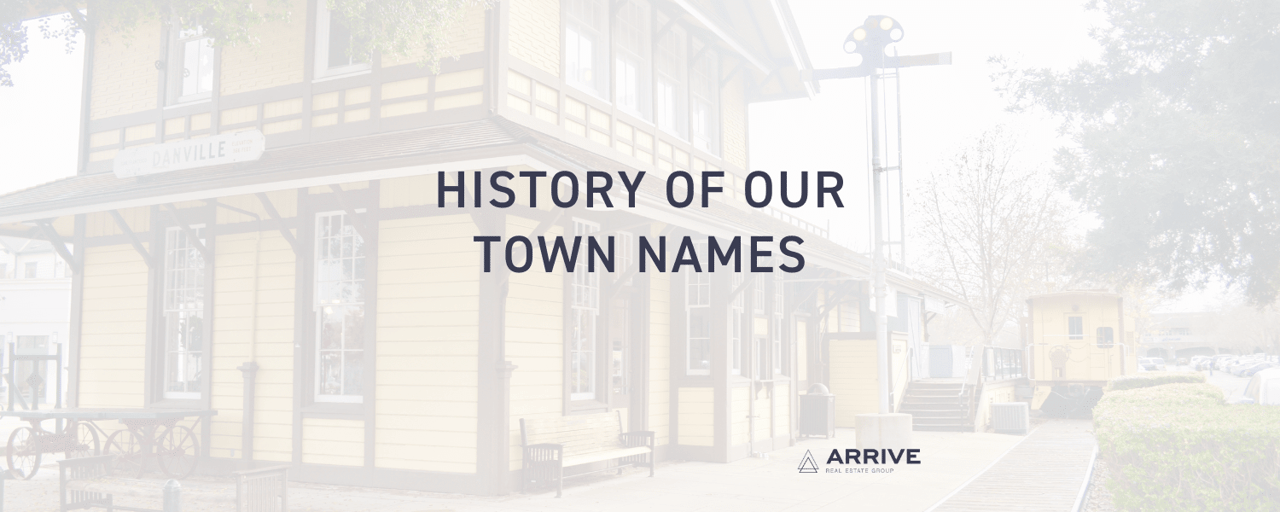History of Our Town Names
Local Area

Local Area

If you’ve lived in the area long enough, you know that the history of the Tri-Valley stems from indigenous Native Americans as well as Spanish and British colonization following the Gold Rush. The Iron Horse Trail was once the Southern Pacific railroad passing through acres of agricultural land and small settlements. But what you may not know, is where our city names came from. Take a look below to find the meaning behind your city and those around us.
The area was named Alamo, which means “poplar” or “cottonwood” in Spanish.
Drawn here by the Gold Rush, Daniel and Andrew Inman purchased 400 acres with their earnings in 1854. By 1858, the area was growing and needed a formal name. Many names were suggested, including Inmanville, but ultimately, the brother’s named the area after Andrew’s mother-in-law who was born and raised near Danville, Kentucky.
Irish settlers bought land from José María Amador and named it Dublin after the original Emerald Isle.
Originally the land was referred to as Acalanus, but the town wanted an identity of its own. Benjamin Shreve came to the area and wanted to call it Centerville but the town rejected it as there was already a Centerville in the state. So he used his second choice, La Fayette. In 1932 it was changed to today's spelling, "Lafayette".
Named after Robert Livermore, a rancher who settled the area in the 1830’s.
Named after Joaquin Moraga who built an adobe on a hill overlooking the Moraga Valley in 1841. The adobe home still stands on a knoll in Orinda above Miramonte High School with a poplar tree-lined driveway going up to the house. However, it wasn't until 1974 that Moraga was officially incorporated.
In 1876, County sheriff and landowner William Walker Camron was married to Alice Mars Camron. Alice enjoyed the poetry of Katherine Fowler Philips, a 17th century English woman known as "The Matchless Orinda." In her honor, the Camrons named their home Orinda Park, later shortened to Orinda.
In 1851, John W. Kottinger named the area, formerly Alisal, after a distinguished Civil War general, Alfred Pleasonton. A spelling error was made during the recording process and the city is now known as Pleasanton.
The name San Ramon is one of the oldest in the area but it was decades before the name was formally given to the city. The creek running through the area was originally named after a Native American who tended the sheep, Ramon. “San” was then added to conform to the usual way Spanish names appear, calling it San Ramon Creek. The village was first known as Brevensville, after a blacksmith, and then became Lynchville after a pioneer who helped build the first two-story house in the area. When settlers from Ireland moved in, they referred to the area as Limerick. Although a post office was established under the name San Ramon in 1873, Limerick was still used to describe the area until 1891 when the San Ramon Branch Line of the Southern Pacific railroad was established.
Originally called “The Corners” by American settlers following the Mexican-American war, it was a place where roads from Lafayette and Pacheco met. The creek running through the area was known as “Nuts Creek” in 1849. In 1855, a hotel was built with the name “Walnut Creek House” and as the region continued to grow, the name of the area was officially changed to Walnut Creek.
At Arrive Real Estate Group, we pride ourselves in knowing the ins and outs of the neighborhoods we work. We raise our families here with our kids attending the local schools, participating in sports and recreation clubs and some of us have even grown up here ourselves! All of this first hand knowledge allows us to best serve our clients.
Stay up to date on the latest real estate trends.
You’ve got questions and we can’t wait to answer them.